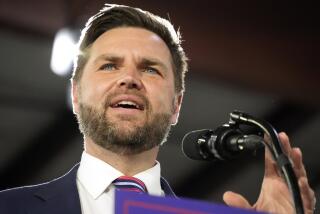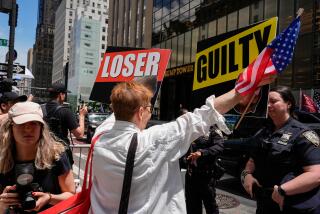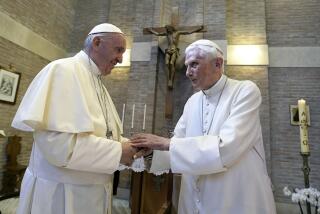Articles of faith -- and dissent
Every traditional creed offers not only its special consolations but also its particular struggle. For Buddhists, it’s the transcendence of dualism in a world of experience that seems everywhere divided. For Jews, there is the continuing renewal of meaning to be wrestled from the sacred texts. For Catholics there is the institutional church.
James Carroll is a prolific poet, playwright, novelist, nonfiction writer and newspaper columnist. “Practicing Catholic” is a memoir -- historic, spiritual and aesthetic -- that recounts his personal progress from a devout Roman Catholic boyhood in the years before the Second Vatican Council, through the seminary and his ordination as a priest of the Paulist order and ultimately his leaving that vocation to become a full-time writer. In the process, he also became a vocal critic of the institutionalized church (particularly what he aptly calls its “absolutist” approach to sexual ethics), its handling of the clerical pedophile scandal and, more recently, authoritarian back- sliding on the conciliar re- forms.
While Carroll’s trajectory may seem a familiar one, he recounts it with great style and peoples it with notable characters, including the peace activists and clergymen William Sloane Coffin and Daniel Berrigan, Thomas Merton, the theologian Hans Kung and the poet and tragic Catholic convert Allen Tate, who was Carroll’s writerly mentor. The author also makes a particular case for the too-often overlooked importance of that great pastoral prelate, the late Cardinal Richard Cushing of Boston, the South Boston-born son of an immigrant Irish blacksmith. It was Cushing’s lifelong affection for his Jewish brother-in-law that, according to Carroll, sensitized this son of tribal Boston to the virtues of American pluralism, led him to excommunicate the anti-Semitic heretic priest Leonard Feeney and to play a pivotal role in Vatican II’s approval of the landmark declaration “Nostra Aetate,” which definitely renounced all forms of anti-Judaism.
--
Matters of loyalty
Carroll’s unspoken assumption that an authentic Catholic practice can be expressed in loyal opposition is a brave but difficult stance. Those who propose it usually are far clearer in their catalog of dissent than they are on precisely what it is they affirm about the church. Carroll is too forthright a writer not to grasp that rhetorical nettle, and he distinguishes between a “collapsing clerical establishment” and “the people” in whom he believes hope still resides. “We maintain our loyalty to the church because we cannot live without it,” he writes. “The church gives us a language with which to speak of God, a Meaning that is God. The church feeds us in the Eucharist, keeps the story of Jesus alive in the preaching of the word, marks our journey through life with the sacraments, and underwrites our participation in the community that transcends space and time.”
Anti-clericalism is the particular peril of disenchanted Catholic intellectuals, and, though Carroll avoids a full tumble into that particular pit, he flirts a bit with the edge and seems to make no place for the clergy in his church-of-the-future. That strikes this reader as odd and inconsistent, since so many of the heroic figures he rightly identifies as significant -- Cushing, Merton, John Courtney Murray, Kung, Pope John XXIII, Coffin -- were and are clerics. The culture that produced these moral giants must have something going for it.
Similarly, it’s hard to tell whether it’s Carroll’s deep-seated disappointment in the institutional church or his love of a good argument that leads him into an occasional lack of nuance -- dare one say a failure of charity -- that is almost coarse. His treatment of Pope Benedict XVI’s relationship to the Jewish community falls into this category. Clearly, the current pontiff has his shortcomings: He is, by all accounts, an eccentric and haphazard manager of the Vatican’s affairs and many believe the Holy See has fallen into administrative chaos since he assumed its direction. He is a withdrawn, very German scholar at a time when the papacy seems to require not just a gifted pastor’s touch but the gifts of a rock star. He is a theological, cultural conservative in an era in which both positions risk being interpreted as aggressive. He is not, as Carroll seems to want to make him, a prelate or theologian who, in any fashion, means to take the church back to its pre-conciliar antipathy toward Jews and Judaism. In fact, as his abject apologies to representatives of the Jewish community show (after the hash the Vatican made of its recent overtures to the Society of St. Pius X), the opposite is true. This is a man who wrote, as theologian Joseph Ratzinger more than a decade ago: “After Auschwitz, the mission of reconciling Jews and Christians permits no deferral.”
--
Aesthetic notion
One strength of Carroll’s memoir -- as with much of his nonfiction -- is that he draws on, though does not credit, E.M. Cioran’s insight that historical consciousness undermines all unorthodoxy, which relies on an untenable insistence that “the body of faith” is unchanging. As Carroll puts it, “Once a believer has learned to think historically, as we have been doing throughout this book, it is impossible any longer to think mythically . . . moving beyond a disenchantment with sacred texts or symbols -- the disenchantment that comes with knowing they are symbols -- to a renewed embrace of the sacred meaning that texts and symbols intend to express.” In this category, Carroll places such pillars of conventional Catholic practice as the Trinity, the Incarnation and the real presence in the Eucharist.
This is an aesthetic notion of Catholic practice that may content a man who once conceived his vocation as priest and poet and, later, “left the priesthood to become a writer.” Carroll, indeed, says, “This is the very definition of my life.” Fair enough and clearly put, but surely others of equally strong conviction would find his aestheticized practice attenuated, perhaps even brittle. To do his argument justice, though, one suspects that Carroll would reply that there are as many authentic Catholic practices as there are sincere Catholics.
In his early career, theologian David Tracy (who provided one of the early, admiring notices on the dust jacket of this memoir) was a disciple of the great Canadian Jesuit Bernard Lonergan, who taught for many years at Harvard and Boston College. Lonergan’s great work was the development of “a method” of inquiry and discourse that would allow the diverse strands of our uniquely human creativity -- the natural sciences, philosophy and theology -- if not to reconcile, then to express themselves intelligibly, perhaps even fruitfully to one another. Ultimately, Lonergan summed up his method in a series of what he called transcendental imperatives: “Be attentive, be intelligent, be rational, be responsible, develop and, if necessary, change”
That well might stand as a description of how Carroll has come to understand the nature of Catholic practice in a church that, as the ancient formulas go, is “simul justus et peccator” (both saved and sinner) and “semper reformanda” (always in need of reform).
--
More to Read
Sign up for our Book Club newsletter
Get the latest news, events and more from the Los Angeles Times Book Club, and help us get L.A. reading and talking.
You may occasionally receive promotional content from the Los Angeles Times.







